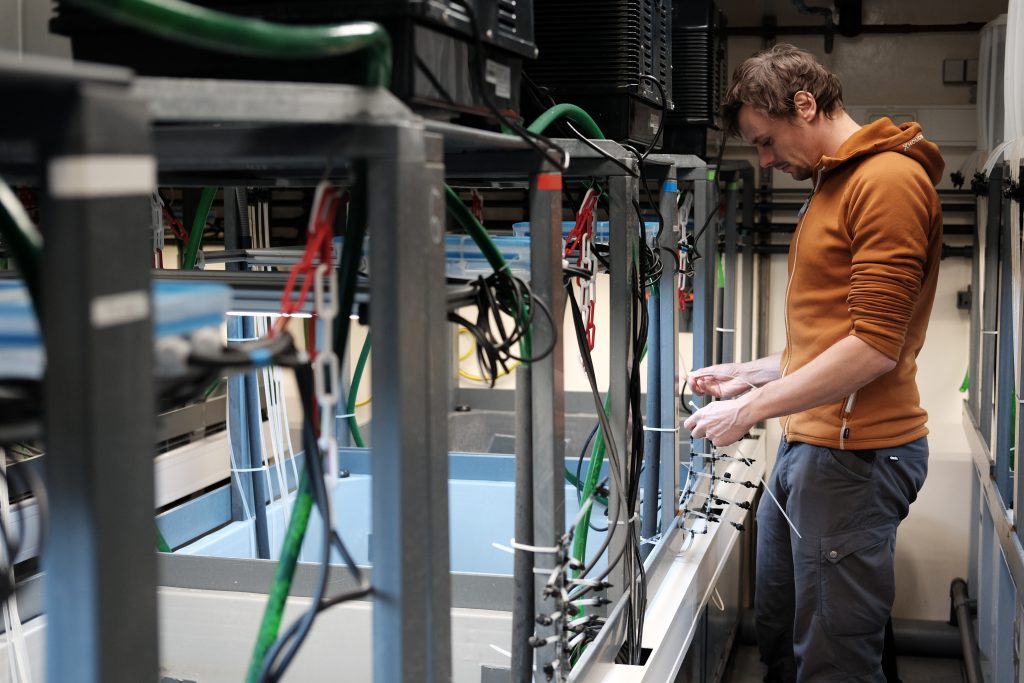The most innovative aspect of our current research is the breaking down of climate change questions to ecologically relevant scales and studying them at exceptionally high resolution. Our main goal is the characterisation of micro- (diurnal temperature and pH) to macroscale (e.g. marine summer heatwaves, freshening- and upwelling events) habitat fluctuations and the response of organisms and communities to this natural variability as well as the extent to which these habitat fluctuations influence (amplify or buffer) future climate change impacts. We recently showed that thermal variability might provide refuge from climate-related stress in an echinoderm and in a bivalve.
To achieve this, we have established mesocosm infrastructure, solely developed to study the effects of environmental variability of multiple drivers (temperature, salinity, pH, light) at various temporal scales (diurnal – seasonal) in single species and communities:
The Kiel Indoor Benthocosms (KIBs), Germany, also at KIBs – mesocosm.org

The Archipelago Benthic Mesocosm Network (ABMN), Finland, also at ABMN mesocosm.org

Current research interests of my group: Climate change and human activities are having pervasive and lasting effects on coastal marine ecosystems. Hypoxic zones are spreading and seawater temperatures, salinity and eutrophication as well as CO2 levels are shifting at rates that are 10-100 times faster than at any point in the last 50 million years, with corresponding effects on biological and ecological processes. Observed responses to these environmental stressors are, however, highly variable among and within species and mechanisms underlying these responses are only beginning to be understood. In most coastal habitats seasonal fluctuations occur naturally and go along with short-term and small-scale shifts, a research field almost entirely lacking observations and experimental data. Acclimation (i.e. phenotypic plasticity), and adaptation (i.e. intraspecific genetic diversity) are key traits that will influence resilience of organisms to environmental stress and, hence the extent of future ecosystem changes. Past research may have missed important aspects by focussing on simple and static systems, single populations and single ontogenetic stages. Zooming in from the scale of entire bays (10s of km) to algal blade surfaces (sub-mm), I will quantify different dimensions of natural habitat fluctuations and investigate the potential for different ontogenetic stages of marine benthic organisms, to acclimate and to adapt to near-future shifts.
PhD and Postdocs phase: I have finished my PhD on “Stress ecology in times of global change – single and combined effects of ocean acidification, temperature and food availability on different life stages of the barnacle Amphibalanus improvisus” at Kiel University / GEOMAR Kiel in summer 2012. I was granted a one-year Postdoc fellowship by The Royal Swedish Academy of Sciences to work as a postdoc at The Sven Lovén Centre for Marine Sciences – Tjärnö from November 2012. The following year, I worked as a Postdoc within the European FP7 Project LEAF – Low Emission AntiFouling (http://leaf-antifouling.eu) at Gothenburg University, Sweden, before I received a Helmholtz Postdoc Grant at GEOMAR, Kiel.
Previous investigations: During the past years, I evaluated – in collaboration with other projects and researchers – a diverse set of dominant invertebrate species within the western Baltic Sea (Amphibalanus improvisus, Asterias rubens, Carcinus maenas, Mytilus edulis, Cerastoderma edule) and their responses to diverse sets of environmental stressors such as ocean acidification, ocean warming, salinity shifts and food availability. My Investigations showed that various life-history stages of the barnacle A. improvises from the Kiel Fjord (Western Baltic Sea, Germany) tolerate high levels of elevated pCO2 well. Since this habitat is highly variable with respect to carbonate chemistry, I hypothesized that the local population might have evolved characteristics making them more tolerant to future ocean acidification than populations from more stable habitats. In the following I investigated the effects of elevated pCO2 on nauplius larvae as well as on newly settled specimens of local populations of A. improvisus in Kiel and in Tjärnö, Sweden. Nauplius larvae showed a strong tolerance to elevated pCO2, regardless of their origin. While however, juveniles from Kiel showed a strong tolerance to elevated pCO2, juveniles from Tjärnö were strongly impaired by similar stress regimes. Long-term acclimation (>12 months) did also not help to overcome this environmental stress, as reproduction was strongly impaired. This gave strong support to the hypothesis that populations are local adapted, highlighting an urgent need in investigating small-scale genetic structures in species populations.
